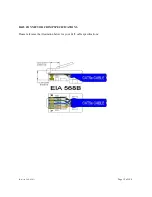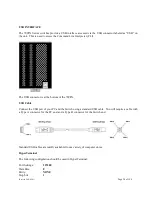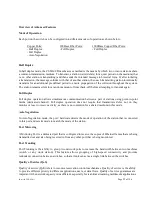
(Revised 2012-05-01)
Page 23 of 196
such as voice over IP, online games and IP-TV, since these often require fixed bit rate and are delay
sensitive, and in networks where the capacity is a limited resource, for example in cellular data
communication. In the absence of network congestion, QoS mechanisms are not required.
Each of these three QOS methods below is included or not based on the settings on the relevant browser
page:
1)
Force High Priority (Port Based),
2)
IEEE802.1p (Tagged QOS), or
3)
DSCP (differentiated services code points) (RFC 2474).
When Force High Priority is enabled, the port based priority is included in the decision for all ports and all
frames received on a port will use the default QOS priority for that port in the decision. For example, if it is
desired to have ingress frames on a port egress to the highest priority transmit queue regardless of other
factors, then enable Force High Priority and set the port's Default Port Priority to 7.
Virtual LAN
The switch provides support for setting up tagged Virtual LANs (Local Area Networks). A port may belong
to any number of Virtual LANs. The VLAN membership of a device is determined by the VLAN(s) that
have been defined for the port to which the device is connected. If a device should move from one port to
another, it loses its current VLAN membership and inherits that of the new port it is connected to.
VLANs facilitate easy administration of logical groups of devices that can communicate as if they
were on the same LAN. Traffic between VLANs is restricted, unless the ports are explicitly configured
as overlapping VLANs. Switches forward unicast, multicast, and broadcast traffic only on LAN segments
that serve the VLAN to which the traffic belongs.
A Default Virtual LAN (VID=1) exists to which a port, which is not a member of any other Virtual LAN,
will belong. This allows the switch to operate as a ‘normal’ switch when it is used in a network. A port is
automatically removed from the Default VLAN when it is reconfigured to belong to another Virtual LAN,
because that is the most common operation. But, if desired, the port can be included in VLAN 1 by
configuring VLAN 1 last.
If switch ports are configured to transmit and receive untagged frames, end devices are able to communicate
throughout the LAN. Using Tagged VLANs, the switch has the ability to take non-tagged packets in some
ports, add a VLAN tag to the packet and send it out tagged ports on the switch. The VLANs can also be
configured to accept tagged packets in tagged ports, strip the tags off the packets, and send the packets back
out other untagged ports. This allows a network administrator to set up the switch to support devices on the
network that do not support VLAN Tagged packets. The administrator can also set up the ports to discard
any packets that are tagged or to discard any packets that are untagged based on a hybrid VLAN of both
tagged and untagged ports, and using the VLAN Ingress Filter on the switch.
For each switch port there is one and only one PVID (port VLAN ID) setting. If an incoming frame is
untagged and untagged frames are being accepted, then that frame will inherit the tag of the PVID value for
that port. Subsequent switch routing and treatment will be in accordance with that VLAN switch map. By
configuring PVIDs properly and configuring for all frames to exit untagged, the switch can achieve a ‘port
VLAN’ configuration in which all frames in and out can be untagged, thus not requiring external devices to
be VLAN cognizant.
Содержание 709FX Series
Страница 1: ...709FX Managed Industrial Ethernet Switch User Manual Installation Guide...
Страница 15: ...Revised 2012 05 01 Page 15 of 196 ACT GREEN Data is active between ports OFF Data is inactive between ports...
Страница 21: ...Revised 2012 05 01 Page 21 of 196 Flow Control NONE...
Страница 32: ...Revised 2012 05 01 Page 32 of 196...
Страница 34: ...Revised 2012 05 01 Page 34 of 196...
Страница 39: ...Revised 2012 05 01 Page 39 of 196 Administration SNMP Continued...
Страница 43: ...Revised 2012 05 01 Page 43 of 196...
Страница 44: ...Revised 2012 05 01 Page 44 of 196 DHCP Server Setup Profiles Continued...
Страница 45: ...Revised 2012 05 01 Page 45 of 196...
Страница 48: ...Revised 2012 05 01 Page 48 of 196 DHCP Server Setup IP Maps Continued...
Страница 50: ...Revised 2012 05 01 Page 50 of 196...
Страница 55: ...Revised 2012 05 01 Page 55 of 196 DHCP Relay Local IP Setup Continued...
Страница 61: ...Revised 2012 05 01 Page 61 of 196 Ports Configuration Continued...
Страница 68: ...Revised 2012 05 01 Page 68 of 196...
Страница 77: ...Revised 2012 05 01 Page 77 of 196...
Страница 82: ...Revised 2012 05 01 Page 82 of 196...
Страница 96: ...Revised 2012 05 01 Page 96 of 196...
Страница 98: ...Revised 2012 05 01 Page 98 of 196 The user can specify the manual router ports...
Страница 100: ...Revised 2012 05 01 Page 100 of 196...
Страница 102: ...Revised 2012 05 01 Page 102 of 196 IGMP RFilter Continued Modifying rfilter port settings...
Страница 111: ...Revised 2012 05 01 Page 111 of 196...
Страница 116: ...Revised 2012 05 01 Page 116 of 196...
Страница 124: ...Revised 2012 05 01 Page 124 of 196...
Страница 126: ...Revised 2012 05 01 Page 126 of 196...
Страница 128: ...Revised 2012 05 01 Page 128 of 196...
Страница 131: ...Revised 2012 05 01 Page 131 of 196...
Страница 133: ...Revised 2012 05 01 Page 133 of 196...
Страница 136: ...Revised 2012 05 01 Page 136 of 196...
Страница 139: ...Revised 2012 05 01 Page 139 of 196...
Страница 142: ...Revised 2012 05 01 Page 142 of 196...
Страница 145: ...Revised 2012 05 01 Page 145 of 196 If a Configuration Device is present that is presented...
Страница 181: ...Revised 2012 05 01 Page 181 of 196...






























